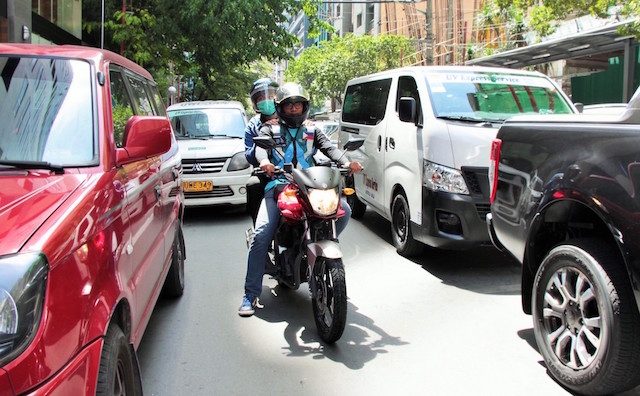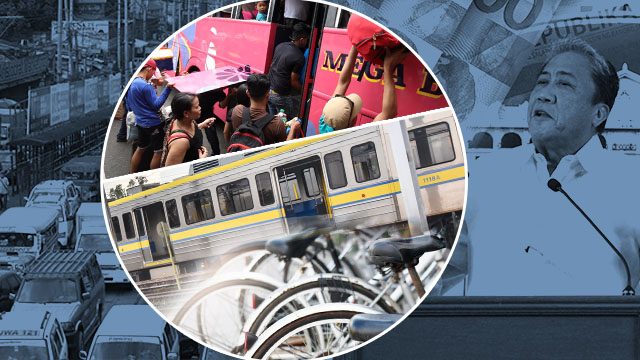SUMMARY
This is AI generated summarization, which may have errors. For context, always refer to the full article.
![[OPINION] Part 2 | Solutions to Manila’s carmageddon](https://www.rappler.com/tachyon/r3-assets/612F469A6EA84F6BAE882D2B94A4B421/img/23E6591B2ACF4B8BB5898427F2294C94/so-what-can-we-do-to-cope_09262019.jpg)

(In the first part of this two-part series, the author discusses the factors that contribute to Metro Manila’s hellish traffic and how it affects the public. Read Part 1 here.)
So what can we do to cope with traffic?
Allow me to share some tips based on my observations and personal experience.
For the commuter
Drivers
Use Waze. Waze is an amazing mobile app, which was probably designed with Manila in mind. You should have this by now if you have a smartphone. For every data you provide, you help other motorists get to their destination more quickly. My favorite feature is its ability to suggest best times to leave. But it has its flaw: it is sometimes unable to detect roadblocks, detours and one-way streets. It is not human, after all.
Listen to podcasts and audiobooks. Turn off the radio and fill the airwaves with the sound of wisdom. Traffic is lost reading time, so this is a great way to catch up. Just download the Podcast app (for iPhone) or Spotify.
If you are an entrepreneur, you will love Masters of Scale by Reid Hoffman, Startup by Gimlet or Business Wars by Wondery. I would recommend Work Life by Adam Grant and the New Yorker Radio Hour episode featuring Robert Caro to CEOs and executives.
The Tim Ferriss Show, Against The Rules by Michael Lewis and Dan Carlin’s Hardcore History are my favorite indulgences. Dan Carlin’s 5-part “Wrath of the Khans” on the history of Genghis Khan is a humdinger.
I have a few leadership audiobooks, but I prefer the long form interviews given by successful people. Tim Ferriss’ interviews with Airbnb co-founder Joe Gebbia, talent manager Shep Gordon and die-hard Muhammad Ali fan Cal Fussman stand out – you will laugh out loud while maybe thinking out loud.
Carpool (when possible). Do give a ride to people you trust, when you must. However, do not feel obligated especially when your schedules do not really align and when they show signs of tardiness. You will get into trouble.
Check your car. I have mentioned earlier what it felt like to feel helplessly stuck behind a car that broke down. I do not want to be that guy who failed to have his carburetor checked. Everyone is busy so let us try to be respectful of their time by being more responsible.
Pack food and water. “Hangry” is not good. Skip the bad mood and load up on nuts, power bars and popcorn that will keep for a while in your car for those unexpected delays in the highways.
Be nice. This should go without saying, but this is the Philippines, where the “I want it now” mindset prevails, even on the road. Drive courteously – you are not the only one in a hurry. And please, signal left or right when you want to switch lanes. Those levers exist for a reason.
Non-drivers
See first two tips under “Drivers.”
Take the train. I used to take the MRT from Quezon Avenue station up to Ayala for over a year, and for a few months to Taft, circa 2000. And at that time, I would already be waiting at the Quezon Avenue station by 5:30 am.
I can only imagine how challenging it must be for train commuters today, especially during rush hour. I would still recommend taking the train during lean times, because it really is a faster mode of transport, without the fear factor of Angkas. When the MRT Line 7 opens, there is a stop quite near where I live. It would be awesome not to have to drive for a change, even for just a short distance.
Use a ride-hailing service. I take Grab frequently, but I must say there is room for improvement. There are times when I have to wait 30 minutess to get a ride. That is not very helpful when moving from one meeting to the next.
I do not think I have the courage yet to ride an Angkas motorcycle, but in times of dire emergency, it would be good to have as an option.
Use waiting sheds. I notice that warm bodies tend to cluster in areas outside of waiting sheds, such as Commonwealth near Don Antonio, or the corner of EDSA and Ayala Avenue. This mad rush to get on the bus is not helping anyone. It eats up a sizable portion of the road, causes traffic, and offends those who are waiting in the designated area.

For the new resident
So you have decided to call Metro Manila your home. Congratulations are in order – you are one brave soul!
If you are moving from a cosmopolitan area, then traffic should be familiar to you. Traffic is traffic, only worse in Metro Manila. So the best way to cope is to live near your place of work.
If you can afford a driver, get one. Local wages are affordable compared to other countries. Live like a royal for a change, even if the carriage is moving slowly.
And if you have somewhere important to get to, always leave early.
For the employer
I would like to think that the work paradigm has begun to shift in the Philippines, no small thanks to traffic. Working 9 to 5 is still the norm, but that seems to be changing. People are spending too much time away from their families, so as a society, we need to find ways to keep them in their homes much longer, and as far away as possible from cars to help lessen the congestion. They are needed at home and at the office, not on the road.
- Senate Bill 1571 or the “Alternative Working Arrangement Bill”
This bill sponsored by Senator Joel Villanueva amends Article 83 of the Labor Code of the Philippines to accommodate work duration beyond 8 hours per day but not exceeding 48 hours per week. When signed into law, companies will be allowed to implement a 4-day work week based on the mutual agreement between the employer and the employee.
I can tell that our legislators are listening, because this is evidence that everyone is feeling the pain.
A simple reorganization of tasks is all it takes to make this work: the employee can do all her meetings in the 4 days that she is physically present at work, and then do the writing and thinking that requires quiet time and minimal distraction at home, maybe even while doing the laundry or roasting the chicken. Multi-tasking at its finest (and most effective)!
Employers should carefully observe the outcomes. Do check if they are effective and adjust where necessary through experiments (see the third tip below).
- Adjust work schedules within the organization
Jobs vary in different industries, so I would assume daily wage earners in manufacturing firms will have to stick to the status quo. But for consulting firms, advertising agencies, financial institutions and government offices, there is room for flexibility.
After briefly going over the Labor Code, I was able to validate that having to work from 9 am to 5 pm is a myth. What the law states is that employees must meet the required 8 hours of work everyday, which could be 7 am to 3 pm, or 8 am to 4 pm.
For example, HR employees who live in Novaliches/QC who work in Makati should consider taking a 7 am to 3 pm shift, during their low season. This assumes that they do mostly administrative work and not a lot of meetings. In that case, they can come to and leave work earlier, and not have to compete for scarce space in the utility vans (UVs), and endure EDSA rush hour traffic.
By doing that, we could help eliminate rush hour once and for all, by spreading out vehicle congestion throughout the day.
- Conduct experiments
CEOs should be open to flexible work arrangements, particularly for high-performing staff. To determine their viability, try experimenting with an employee by requiring an increase in daily output (say, 4 designs rather than the usual two a day) in exchange for a 3-days-a-week work schedule. It is very likely that the staff will deliver, especially if the 3-day arrangement is giving her a much-needed reprieve from traffic and quality time with her children.

For the employee
I previously mentioned the mental, emotional and physical toll of traffic on us, which should be obvious to many of you who come home to your families drained with nothing left, on a daily basis. I used to be that person, and that was the worst version of myself. It took some time for me to believe that I deserved better, that life wasted on a busy road is not for me, and that there are workarounds to this crisis.
- Ask for it
If you believe that you have done well for yourself, and have contributed significantly to the success of your company, then ask for more time from your boss, if that is what you want.
If given a choice, I would personally choose more time than money because it will help ensure improved health (i.e. more sleep, better habits) and better performance. No job is worth losing my health over, but that is just me.
- Start a side hustle
If you are single, you do not need much to get by, unless you do not intend to just get by and would like to have your own business.
If you are married with kids, and struggling to make ends meet, ask your boss for a more flexible work arrangement so you can also manage the household and get started on a part-time business. There are many options around, especially online. (If you would like to know more, send me a private message on LinkedIn. I conduct workshops on entrepreneurship for non-entrepreneurs, non-profit employees and volunteers, and families of OFWs.)
- Replace Netflix with podcasts or skills training videos
Sharpening the saw should be a lifelong commitment. There is nothing to gain by spending our “free time” while waiting for the P2P bus watching Stranger Things or stalking your crush on Facebook.
See the second tip under “Drivers” for podcast recommendations. There is much to learn from people who are more successful than us, and in podcasts, they are very generous with their ideas.
And we need to grow ourselves if we want to be good at business and at work. Waiting time is not free time. It is lost time. Let us use it productively.
- Be so good your boss can’t ignore you
In the end, you might surprise yourself: all those practical learnings from the podcasts and real-life experience running your own part-time business will carry over to your job. Your values will shine through. Upgrading your skills will make you more committed to success, and your boss will love you.
If not, then maybe it is time to grow your online business, earn enough to replace your day job, fire your boss, and move on to greener pastures.
For the entrepreneur
There is real opportunity in the chaos that is traffic, and I think this is the best time to be an entrepreneur. I honestly do not think I would go this route (I have a consulting practice and a wellness distribution business) if not for wasted time in the car.
But goods still have to be delivered and prospects have to be met, so there is still no escaping traffic. Here are some ideas that have worked for me to help ease the burden:
- Hire an assistant
I have had two short-lived assistants. They were helpful in managing my databases and drafting some copy. The downside is, they are also new graduates looking for “real” work in a corporate setting.
Tim Ferriss’ The 4-Hour Work Week comes to the rescue, at the most opportune time. He recommends hiring a virtual assistant from a company, not an individual, so that in case of sudden absence, the work can still be completed. Brilliant.
I am still open to hiring local assistants, possibly stay-at-home moms, because they are just as allergic to traffic as I am. We shall see. I am open to anything that will help me achieve more.
- Outsource logistics
I still do personal deliveries, especially for my top clients, but props to Lalamove and Grab for creating the motorcycle delivery alternative. I have become an avid user. I certainly approve of more motorcycles on the road (though they can be a safety hazard) because they have a smaller carbon footprint, though as a car driver in near-death clashes I might regret that statement.
- Build an online platform
If your business is entirely offline, you may want to consider creating a website to attract more customers. It is definitely easier to build a website now complete with domain hosting and payment functionalities than before. I use Wix and I got set up in a less than an hour. Facebook and Instagram are also very useful in building trust (Note: Building trust, not selling products. Everyone wants to buy, but no one really wants to be sold to – thanks Chris Guillebeau).

For the concerned government agencies
Calling the MMDA, Philippine National Police Highway Patrol Group, and the Department of Transportation. I know you are doing your best. If you are open to more suggestions, I think we need better driver skills which can be addressed through more rigorous driver aptitude tests. Can we also do something about common sense alternatives in local governments?
Here’s an example: the traffic lights at BGC do not make sense. If I am on the rightmost lane, and the light is green, why is the pedestrian lane I am approaching also a go?
Come to think of it, I have a list of strange traffic rules. How about you?
For the legislator
And finally, I appeal to our lawmakers to echo more loudly the people’s silent rage. We all hate traffic, and what it does to our society, and I know you feel it too. It is hard to move forward, as a country, with this pain point constantly holding us back.
In conclusion, allow me to share some ideas I have thought about which I hope will help mitigate our collective suffering:
- Support the alternative working arrangement bill
- Draft bills that support the infrastructure development roadmap proposed by JICA
- Re-evaluate the responsible parenthood bill to make contraceptives more accessible to urban residents
- Draft bills that support sanctions for bus and other transport operators that worsen traffic in the city
- Recognize local governments that implement common-sense traffic ordinances
I am not a lone wolf crying out in the wilderness. The groundwork by other legislators and concerned citizens has already been laid. I only ask that you (re)consider them.
“There are no traffic jams along the extra mile.” – Roger Staubach
I hope he is right. – Rappler.com
Mai Mislang is a non-profit consultant and musician. She writes on Medium and Thrive Global on productivity, social issues, travel, and music.
Add a comment
How does this make you feel?
There are no comments yet. Add your comment to start the conversation.